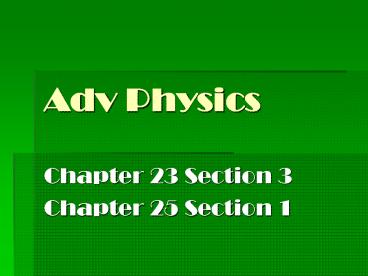Adv Physics - PowerPoint PPT Presentation
1 / 16
Title:
Adv Physics
Description:
Adv Physics Chapter 23 Section 3 Chapter 25 Section 1 Lenses Lens equation 1/f = 1/d0 + 1/di Magnification equation m = -di / do Convex Concave f + - do + + di ... – PowerPoint PPT presentation
Number of Views:50
Avg rating:3.0/5.0
Title: Adv Physics
1
Adv Physics
- Chapter 23 Section 3
- Chapter 25 Section 1
2
Lenses
- Lens equation
- 1/f 1/d0 1/di
- Magnification equation
- m -di / do
3
Convex Concave
f -
do
di real - virtual - virtual
m upright - inverted upright
4
Sample Problem
- A 2 cm tall object is placed 7.5 cm to the left
of a convex lens whose focal length is 11.8 cm.
Find the image distance and determine whether the
image is real or virtual. Determine the
magnification and the image height.
5
Sample Problem
- An object is placed 7.1 cm to the left of a
diverging lens whose focal length is 5.08 cm.
Find the image distance and determine whether the
image is real or virtual. Obtain the
magnification.
6
The Eye
- Air to cornea (n1.38)
- Cornea to aqueous humor (n1.34)
- Aqueous humor to lens (n1.42)
- Lens to vitreous humor (n1.34)
- Light strikes the retina where image is formed
7
Accomodation
- Process of adjusting the shape of the lens to
focus on different objects - - accomplished using the ciliary muscles
- - muscles are relaxed to make the lens flatter
to see distant objects - - muscles are tightened to make the lens more
curved to see close objects
8
Normal Vision
- Near point closest point that can be seen as a
clear image - - usually at about 25 cm from the eye
- Far point farthest object that can be seen as a
clear image - -so far away we call it infinity
9
Myopia
- Nearsighted
- Defect in the eye in which the eye is unable to
see clearly distant objects - Image formed by eye is in front of retina
10
Myopia
- Corrected using a concave lens
- Image is now formed at the far point
- Using a concave lens alters the near point!
11
Sample Problem
- Find the optical power necessary to correct an
eye with a far point of 50 cm. Neglect the
distance from the lens to the cornea. - Hint Optical power 1/f
- If the eyes near point was 10 cm, what is the
eyes corrected near point?
12
Hyperopia
- Farsighted
- Defect of the eye in which the eye is unable to
see close objects - Image is formed behind the retina
13
Hyperopia
- Corrected using a convex lens
- Image is now formed at the near point
- Using a convex lens alters the far point!
14
Sample Problem
- Find the power of a lens designed for reading
purposes to correct an eye with a near point of
75 cm. Assume a standard reading distance of 25
cm. Neglect the distance from the cornea to the
corrective lens.
15
Blind Spot
- Region of retina where there are no
photosensitive receptors and the optic nerve
leaves - Approx 1.5 mm in diameter
- when image is formed on this spot it is lost
16
Fovea
- Most sensitive part of retina
- Near its center
- Approx 0.4 mm in diameter
- Image formed here is most clearly seen































